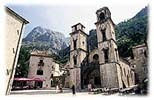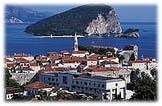|
||||||||||||||||||
PRIVATE TOURS TO MONTENEGRO FROM DUBROVNIK
Private taxi tours from Dubrovnik to Montenegro. Several routes are on disposal: - Dubrovnik - Igalo - Herceg Novi - Kotor - Sveti Stefan - Budva - Tivat - Dubrovnik - Dubrovnik - Igalo - Herceg Novi - Kotor - Cetinje - Sveti Stefan - Budva - Tivat - Dubrovnik - Dubrovnik - Trebinje - Niksic - Podgorica - Sveti Stefan - Budva - Tivat -Dubrovnik other routes by request
GEOGRAPHICAL POSITION OF MONTENEGRO The territory of Montenegro stretches from the east border of Herzegovina across the high mountains of Durmitor, Pivska, Bjelasica and Ljubišnja, extending to the edges of Volujak and Zelengora Mounts in the north, Prokletije in the south-west, and ending with the picturesque coastal area of the Adriatic Sea. It latitude ranges between 41°58°N and 43°32°N and the longitude between 18°58°E and 20°21°E. SURFACE AREA The continental part covers an area of 13,812 km2 and the length of the Montenegrin Adriatic coastline is 293 km. The average altitude above sea level is 1,060m with around 70 mountain peaks reaching 2,000 m. POPULATION The population is 672,656 of the following national composition: Montenegrins, Serbs, Albanians, Bosnians, Croats, and others. CLIMATE There are several climate zones: moderate continental in the inland part, Alpine in the highlands and Adriatic- Mediterranean along the coastline with many warm and sunny days where an average temperature in January never drops below 7°C and is around 25°C in July. The sea temperature in the winter months ranges from 10-12°C and 25-28 ° in the summer.
KOTOR
The old town of Kotor is one of the best-preserved medieval towns in this part of the Mediterranean. It was succeeded in preserving its original form, so typical of towns between the XII and the XIV century. The asymmetric structure of the narrow streets and squares, combined with the numerous valuable monuments of medieval architecture, contributed to Kotor being placed on UNESCO’s “The world natural and cultural inheritance” list. The cultural inheritance of this town is enriched by the unique architectural styles and the ambient atmosphere. The fortification system of Kotor, which protects it from the sea, is actually a wall 4.5 km long, 20 m high and 15 m wide, and is preserved as one of the world’s historic values. The construction of the ramparts was initiated in the Illyrian age and they were built and rebuilt up to the XVIII century. The oldest town gate, of the three existing in the town, is the “South” gate which was partially constructed in the IX century. The “North” and the “Main” gates were build in the renaissance style by the first half of the XVI century. The most representative monument of Roman architecture in the Adriatic is the magnificent Cathedral of St. Tiphun, constructed in 1166 and built on the remains of the former temple from the IX century. There are the remains of the frescos from the XIV century and the valuable treasury with domestic and Venetian golden works dating from the XIV to the XX century. Besides the cathedral, in the hart of the town, there are magnificent examples of sacral architecture originating from XII till XX century. - The Romanic church of St. Lucas was built during the reign of the great ruler Nemanja and his son Vukan in 1195. - The Romanic church of St. Ana dates from the end of the XII century and has frescos dating back from the XV century. - The Romanic church of St. Mary dates from 1221. The church contains the remains of a monumental fresco painting as well as an early Christian baptistry. - The Gothic church of St. Mihovil was built on the remains of the Benediction monastery from the VII century with frescos dating back from XV century. - St. Clara’s church dates from the XIV century with the extremely beautiful marble altar, the work of Francesco Cabianca, from the XVIII century. - The Church of Lady of health originates from the XV century. - The Orthodox Church of St. Nicolas was built by the beginning of the XX century with a valuable collection of icons. There are also numerous palaces in the town: the Drago
palace with Gothic windows from the XV century, the Bizanti palace from the
XVII century, the Pima palace, with typical renaissance and baroque forms
from the XVI century the Grubonja palace with the built-in emblem of the old
Kotor’s pharmacy established in 1326; the Grgurina palace, from the XVII century,
which today contains the Naval museum, and finally the Clock tower, from the
XVI century, with the medieval pillory just beside it. BUDVA
Budva is considered one of the oldest settlements in the Balkans. The legend, confirmed by Greek mithology, says that Budva was established by Cadmo, the son of the Phoenician king Agenon. He was expelled from Thebes and arrived by ox-drawn car in this area where he started Budva. The old town of Budva lies on a little island that was linked to the land by a sandbar and in time turned into a peninsula. It is surrounded by ramparts originating from the XV century including a medieval fortification system with city gates, defense walls and towers. Inside the walls the town is a combination of narrow streets and little squares with valuable monuments of different Mediterranean cultures that marked its development: - The St. Ivan’s church, VII century, has pictures and icons by Venetian artists from the XV - XVII century. There is a library in the church and an archive where valuable examples of the old church books are kept. - The Church of St. Mother of God, Mary in punta, was built by the Benedictines in 840. - The St. Sava church originated from the period of Nemanjici in the XIV century. It was first mentioned in 1413 in the Charter of the Zeta’s ruler Balsa III. - The St. Trinity church is from 1804. There is a grave of Stjepan Mitrov Ljubisa, a famous writer, in front of the church. The church is located in the old town in front of the Citadel. Today Budva is a center of tourism and a city of theatre, festivals and celebrations. It is a summer stage for cultural productions.
Travel to Montenegro - Your detailed travel guide to Montenegro with photos and picture galleries. Useful travel information, maps, online hotel booking, cheap flights, car rental. Transfers from Dubrovnik airport to Montenegro destinations www.montenegro-transfers.com
. |
| ||||||||||||||||||

